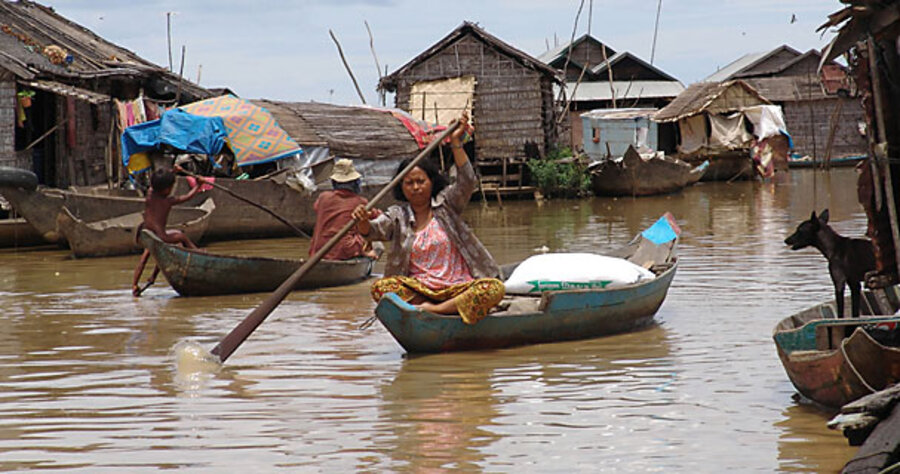In Cambodia, a case for localizing climate-change research
Loading...
| Siem Reap, Cambodia
Nam Lai, a carpenter in this remote corner of Cambodia, remembers when it was easy to park his movable houseboat on the Tonle Sap Lake where he lives. But now, it’s getting harder to find a suitable spot for his small barge. “I have to move the house farther and farther from the shore,” he says.
For years, the 1 million inhabitants of the lake – Southeast Asia’s largest freshwater body – have lived a mobile existence to keep step with the seasonal ebbs and flows brought on by monsoons and melting Himalayan snows that expand the lake to five times its normal size. But many villagers say the deeper waters needed to park their houseboats are harder to find as the summers get hotter and the lake’s water level drops.
Lai’s observations, together with evidence of climate change’s impact on other fisheries around the world, has scientists deeply concerned that Tonle Sap Lake – one of the world’s most fragile ecosystems and one of its most productive fisheries – is also under threat. The lake is essential to Cambodia’s food supply, its fish providing 60 percent of the country’s protein, while supporting the livelihoods of about 12 percent of its people.
The problem is, nobody knows the impact of climate change for sure – even the teams that have come to find out from as far away as Finland – since scientific inquiry has only just begun. Observers say that the uncertainty underscores that better understanding of local scenarios, not just global modeling that looks at steady increases in world-wide temperatures, is needed to pinpoint climate change’s impact on people and livelihoods.
“There’s a whole area of science that needs to relate climate and physical change to people and social changes – to identify relationships between physical changes and social consequences,” says Eric Baran, research scientist at the Phnom Penh office of the World Fish Center, a research organization headquartered in Malaysia.
The Cambodian government has begun looking at the problem, creating a climate-change office in 2003 and undertaking a climate-change vulnerability assessment in 2001. But neither of those measures has focused specifically on the Tonle Sap Lake. Some pioneering studies, including one at Africa’s Lake Tanganyika, have linked some of the same problems the Tonle Sap is exhibiting – such as reduced fish yield – to climate change. But it’s not yet clear whether climate change or other factors are responsible here.
Whatever the cause, floating gas-station owner Sinan San has seen the effects firsthand. Her main customers – fishermen – are no longer able to make good catches, and her earnings have dried up since 2004.
“The number of fishermen has decreased because there are less fish, and they move to upland for their livelihood. They say fish are getting smaller and smaller,” she says. Scientists agree, saying overfishing, poor management, and unfair laws have led to a sharp decrease in the number and size of the lake’s fish.
“Small fish are more susceptible to climate fluctuations,” says Mr. Baran. “If the year is good, you have many [small fish]. If the year is bad, you have nothing. This will make the system more and more shaky.”
The declining fish are just one variable in a host of factors that threaten to affect the lake’s hydrology, further exposing it to the risks of climate change.
“Many factors will have impacts on the hydrological regime of the Mekong Basin and on the Tonle Sap Lake’s ecosystem,” Timo Menniken, an adviser to the Mekong River Commission Secretariat in Vientiane, Laos, writes in an e-mail. “These include general rapid economic development, the ongoing development of hydropower schemes along the upper reaches of the Lancang-Mekong, the proposed development of hydropower schemes on tributaries and the mainstream in the lower basin, the indications of groundwater depletion and water pollution caused ... by the tourism industry, and plans for oil exploration in the Tonle Sap Basin.”
Another factor is accelerated glacier runoff. “The hydrology can be affected by the melting away of mountain snows in Tibet. You may see water levels rise, which would cause salinity levels to rise,” says Neou Bonheur, the project director of the Ministry of Environment’s Tonle Sap Environment Management Project. “We just don’t know. There are a wide range of areas that we need to set up and observe.”





